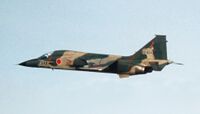Mitsubishi F-1
The Mitsubishi F-1 is Japan's first post-World War II domestically developed and built supersonic military jet, to enter production in Japan since the end of World War II, thus it was nicknamed "Supersonic Rei-Sen". Mitsubishi Heavy Industries and Fuji Heavy Industries jointly developed the F-1. At first glance, it resembles the French/Anglo SEPECAT Jaguar, but was a completely independent Japanese effort (although it uses the same engines). Its primary role is anti-ship attack, secondary role is ground attack, and it has limited air-to-air capabilities (short-range AIM-9 Sidewinder for self-defense).
The F-1 was replaced by the F-2 (Japan/U.S. developed, based on F-16C/D Agile Falcon), as well as upgraded F-4EJ "Kai" Phantom IIs. The last six active F-1s, based at Tsuiki in Fukuoka Prefecture, were retired on March 9th 2006, having reached the 4,000 hour limit of their airframes.
Variants[edit | edit source]
- FS-T2-Kai: The first two prototypes.
- Mitsubishi F-1: Single-seat close air support, ground-attack and anti-ship fighter aircraft.

